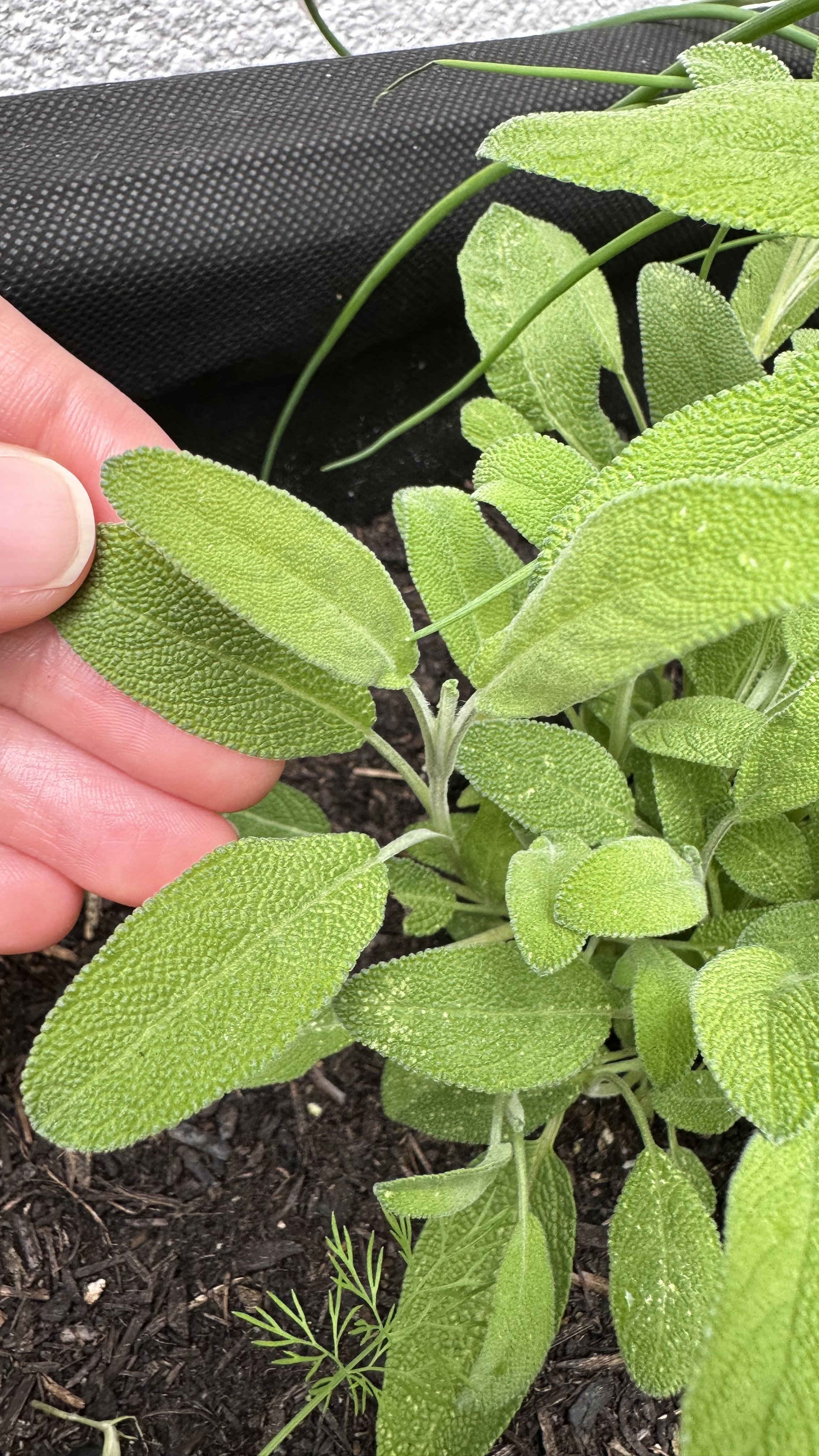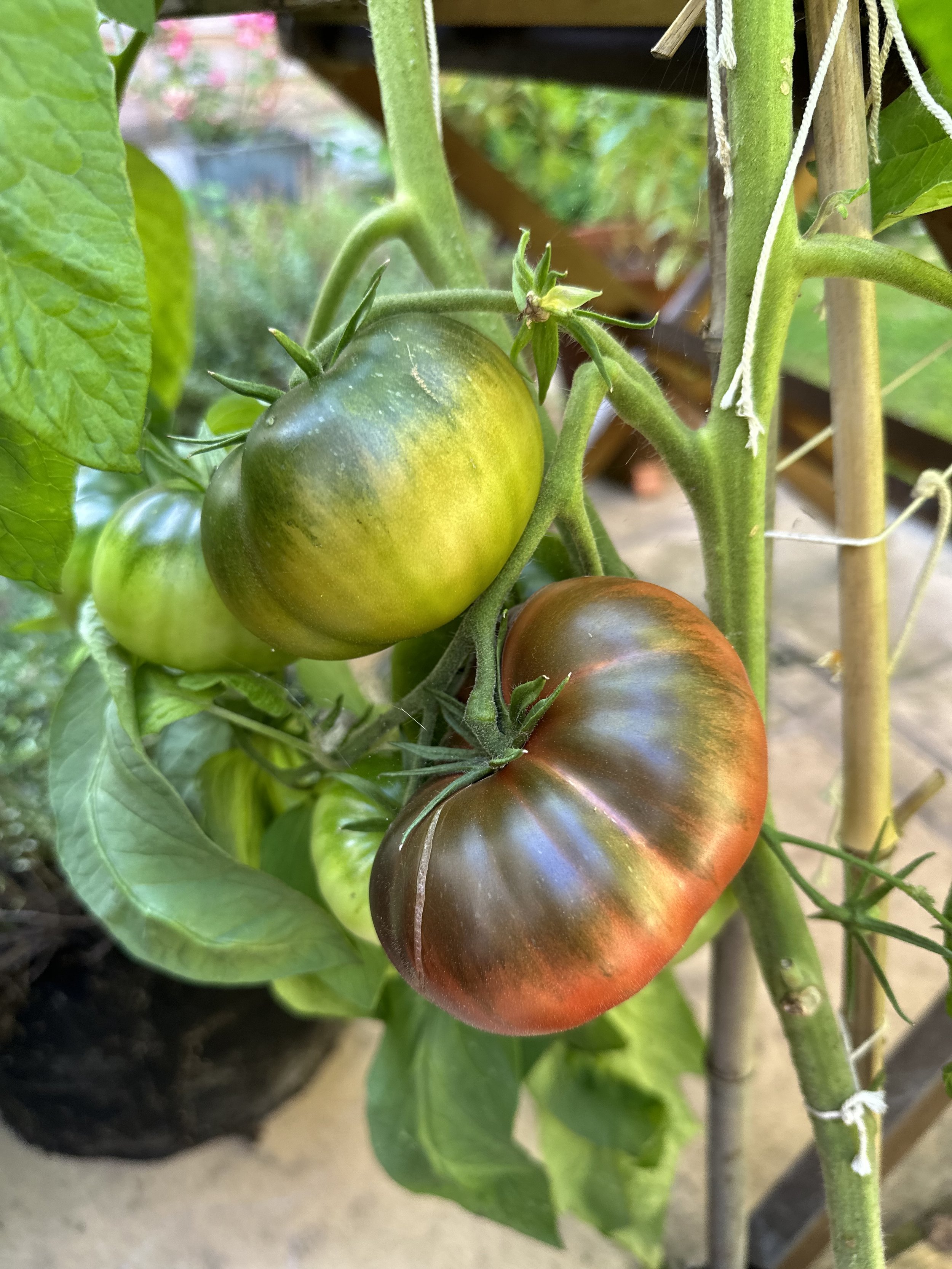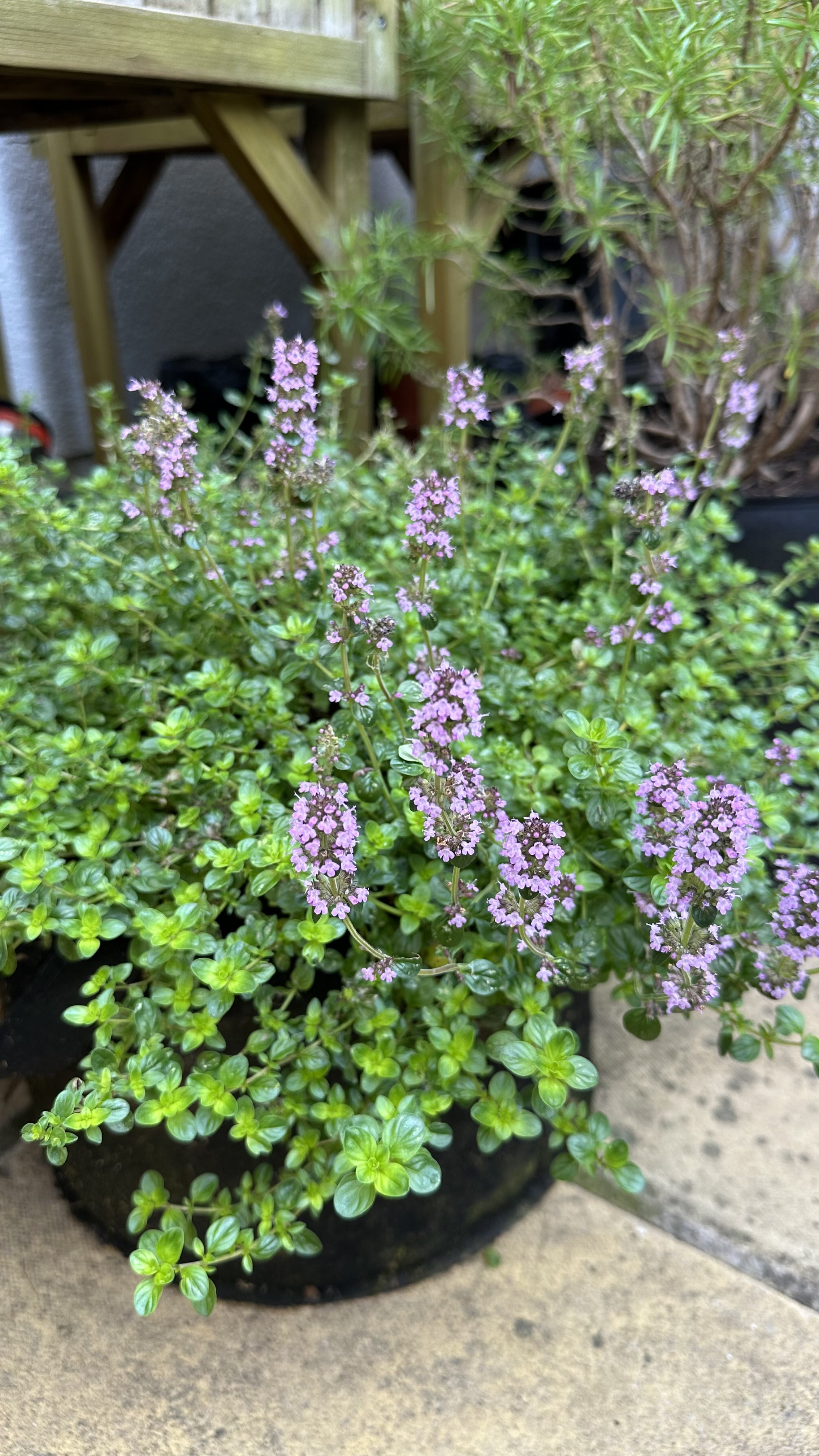Companion Plants for Thyme
This website is reader-supported - thank you! This post may contain affiliate links. As an Amazon Associate, I earn from qualifying purchases at no extra cost to you.
I've always had a soft spot for thyme plants in my garden.
Over the years, I've learned that choosing the right companion plant for thyme can make a big difference in how well everything grows.
In this guide I'll share my experiences with thyme companion plants and how they've helped me create a healthier, more productive herb garden.
To learn more about growing thyme, check out my guide:
Best Companion Plants for Thyme
Here are the companion plants that I recommend growing with thyme:
1. Rosemary
In my experience, rosemary and thyme are like the dynamic duo of the herb world.
Both prefer full sun and well-drained, slightly sandy soil, which means they thrive under similar conditions.
Planting them together simplifies their care routine, allowing you to meet their growing requirements without extra effort.
I've noticed that rosemary doesn't just coexist with thyme—it actually enhances the overall health of my herb garden.
Rosemary releases natural oils that deter common pests, making it a great companion for thyme and other nearby plants.
At the same time, it attracts beneficial insects like bees and butterflies, which are essential for pollination.
Having rosemary and thyme side by side is also a culinary advantage.
I love stepping into my garden to pick fresh sprigs of both herbs for cooking.
They complement each other beautifully in recipes, from roasted meats to savory breads.
It's convenient and adds a burst of flavor to my dishes.
Another benefit I've observed is how rosemary's taller growth can provide a bit of shade for thyme during the hottest part of the day.
This natural shading helps prevent the soil around thyme from drying out too quickly, maintaining just the right amount of moisture.
It's a subtle interaction, but it makes a noticeable difference in the plants' vitality.
Here is the rosemary I recommend growing:
To learn more about growing rosemary, check out my guides:
2. Sage
In my herb garden, sage and thyme are like close companions that complement each other in many ways.
Both herbs enjoy similar growing conditions—plenty of full sun and well-drained soil—which makes it easy to care for them side by side.
Planting them together has streamlined my gardening routine since I can water and tend to them simultaneously without worrying about differing needs.
One of the biggest advantages I've noticed is how sage enhances pest control in the garden.
Sage has natural properties that help repel pests such as cabbage moths and flea beetles.
When planted near thyme, the combined scents of these herbs create a more effective deterrent against these unwanted visitors.
This natural pest control method has reduced my reliance on chemical pesticides, making my garden more organic and eco-friendly.
I've noticed an uptick in pollinator activity since pairing these herbs together, which has had a positive impact on my garden's overall health.
From a culinary standpoint, having fresh sage and thyme readily available is incredible.
I often use them together in recipes, especially in roasted dishes.
The convenience of harvesting both herbs from the same area saves me time when cooking and ensures I always have fresh ingredients on hand.
Additionally, sage can offer a bit of physical protection to thyme.
Since sage can grow slightly taller, it provides a modest amount of shade during the hottest parts of the day.
This can help prevent the soil around thyme from drying out too quickly, maintaining the right level of moisture without overwatering.
Here is the sage I recommend growing:
To learn more about growing sage, check out my guides:
3. Parsley
Pairing parsley with thyme has been both enjoyable and beneficial, even though they have slightly different needs.
Parsley prefers moist soil, while thyme thrives in well-drained, drier conditions.
At first, I was concerned about this difference, but I discovered that with a little attention, they can coexist happily.
To accommodate both plants, I plant parsley and thyme close together but not directly side by side.
I make sure to water the parsley more generously, keeping its soil moist, while being careful not to overwater the thyme.
Sometimes, I use mulch around the parsley to retain moisture without affecting the thyme's preference for drier soil.
This setup allows both herbs to flourish in the same garden space.
Parsley is excellent at attracting beneficial insects like ladybugs and hoverflies.
These insects help control pests such as aphids and caterpillars that can damage other plants in the garden.
By planting parsley near thyme, I've noticed an increase in these helpful insects, which has contributed to a healthier garden overall.
Here is the parsley I recommend growing:
To learn more about growing parsley, check out my guide:
4. Brussels Sprouts
I've found that pairing Brussels sprouts with thyme in a vegetable garden is a game-changer.
Brussels sprouts are a favorite of mine, but they can be a magnet for pests like cabbage worms, cabbage moths, and flea beetles.
These pests can cause significant damage if left unchecked.
Thyme acts as a natural deterrent against these common pests.
The strong scent of thyme confuses and repels insects that would otherwise target Brussels sprouts.
One of the practical benefits I've found is that thyme and Brussels sprouts make efficient use of garden space.
Brussels sprouts grow tall, while thyme stays low to the ground.
Planting thyme around the base of Brussels sprouts acts like a living mulch, helping to suppress weeds and retain soil moisture.
This setup maximizes space and enhances the growing conditions for both plants.
Both thyme and Brussels sprouts thrive in full sun and appreciate well-drained soil.
While Brussels sprouts prefer slightly more moisture than thyme, I've managed this by careful watering.
I water the Brussels sprouts adequately while ensuring the thyme isn't overwatered.
Mulching around the plants also helps maintain the right soil moisture levels.
Here are the Brussels sprouts I recommend growing:
For more herb growing tips, check out my guide:
5. Tomatoes
In my gardening adventures, pairing thyme with tomatoes has been one of the most fruitful decisions I've made.
Tomatoes are a staple in my summer garden, and integrating thyme has brought several advantages that enhance both plant health and harvest quality.
One of the primary benefits is thyme's ability to repel pests like tomato hornworms.
These pesky caterpillars can wreak havoc on tomato plants by devouring leaves and fruit.
The strong scent of thyme confuses and deters these pests, reducing the likelihood of an infestation.
Since I started planting thyme near my tomatoes, I've noticed a significant decrease in hornworm damage, which means healthier plants and better yields.
Thyme isn't just good at keeping pests away; it will also attract pollinators such as bees and parasitic wasps.
These insects play a crucial role in pollinating tomato flowers and controlling other unwanted pests.
The increased pollinator activity has led to more abundant fruiting in my tomato plants, and the presence of parasitic wasps helps keep other harmful insect populations in check.
Both tomatoes and thyme thrive in full sun and prefer well-drained soil, making them compatible companions.
While tomatoes require more consistent moisture, I've found that planting thyme at the base of tomato plants doesn't hinder either plant.
The thyme acts as a living mulch, helping to suppress weeds and retain soil moisture for the tomatoes without overwatering itself.
This setup maximizes garden space and creates a microenvironment where both plants can flourish.
I often find myself plucking ripe tomatoes and a few sprigs of thyme to create fresh salads and roasted dishes.
The convenience of having both ingredients on hand encourages me to experiment in the kitchen and enjoy the freshest flavors possible.
Here are the tomatoes I recommend growing:
To learn more about growing tomatoes, check out my guides:
Tips for Successful Companion Planting with Thyme
1. Soil Conditions
From my experience, the foundation of a thriving garden starts with the right soil.
Thyme prefers well-drained, slightly dry soil.
If the soil retains too much moisture, thyme can develop root rot or other fungal diseases.
To ensure proper drainage, I often mix sand or small gravel into the soil where I plant thyme.
When choosing companion plants, I make sure they also appreciate similar soil conditions.
Herbs like rosemary and sage are great examples, as they, too, prefer well-drained soil.
This way, all the plants can thrive without compromising their individual needs.
2. Sunlight Requirements
Thyme is a sun-loving herb that flourishes in full sun, meaning it needs at least six to eight hours of direct sunlight each day.
I've noticed that when thyme doesn't get enough sunlight, it becomes leggy and less flavorful.
Most of its ideal companions, like rosemary, sage, and tomatoes, also enjoy plenty of sunlight.
When planning my garden, I position taller plants in a way that they don't cast excessive shade over the thyme and its companions.
Ensuring all plants receive adequate sunlight helps them grow robustly and enhances their natural flavors and pest-repelling properties.
For more herb garden inspiration, check out my guides:
3. Watering Practices
Balancing the watering needs of different plants can be a bit tricky.
Thyme is drought-tolerant and doesn't require much water once established.
Overwatering can lead to weak growth and make the plant susceptible to diseases.
However, some companion plants might need more frequent watering.
For instance, while thyme prefers dry conditions, parsley enjoys moist soil.
To accommodate both, I water thyme sparingly and focus more on the plants that need additional moisture.
Sometimes, I plant moisture-loving herbs slightly downhill from thyme so excess water naturally flows toward them.
Mulching around moisture-loving plants can also help retain soil moisture without affecting the thyme.
4. Spacing and Air Circulation
Proper spacing is crucial for plant health.
I make sure to give each plant enough room to grow without competing for nutrients, water, or sunlight.
Adequate spacing also improves air circulation, reducing the risk of fungal diseases.
For thyme, which can spread out as it grows, I leave about 12 to 18 inches between it and other plants.
This spacing allows thyme to fill out without encroaching on its neighbors.
It also makes it easier for me to access each plant for harvesting and maintenance.
Check out my guides for more herb garden tips:
5. Soil Nutrition
Thyme doesn't require highly fertile soil and actually produces more flavorful leaves in leaner conditions.
Over-fertilizing can lead to excessive foliage growth with less intense flavor and aroma.
When planting thyme with companions that might need richer soil, like tomatoes or Brussels sprouts, I balance the soil nutrition.
I might add compost or organic fertilizer to the areas where nutrient-loving plants are located while keeping the soil around thyme less amended.
This approach ensures each plant gets what it needs without compromising the others.
6. Pest Management
One of the perks of planting thyme is its ability to repel pests naturally.
Thyme emits a scent that deters insects like cabbage moths, flea beetles, and tomato hornworms.
To maximize this benefit, I plant thyme near vegetables and herbs that are prone to pest infestations.
By doing so, I've noticed a significant reduction in pest-related damage.
Additionally, thyme attracts beneficial insects such as bees and ladybugs, which help with pollination and controlling harmful pest populations.
7. Garden Layout Planning
Thoughtful garden design enhances the effectiveness of companion planting.
I like to group plants based on their watering needs and growth habits.
Taller plants are positioned so they don't overshadow shorter ones like thyme.
I also consider the harvest frequency; plants I use often are placed where they're easily accessible.
By planning the layout carefully, I ensure that each plant contributes positively to the garden ecosystem.
8. Monitoring and Maintenance
Regular observation is key to successful gardening.
I keep an eye on my plants for signs of stress, pests, or diseases.
Early detection allows me to address issues before they become significant problems.
For thyme, I watch for signs of overwatering, such as yellowing leaves or a wilting appearance.
Adjusting care practices promptly helps maintain plant health.
9. Seasonal Considerations
Understanding the seasonal needs of thyme and its companions helps in planning and care.
Thyme is a perennial herb that can survive mild winters, but harsh conditions may require protection like mulching or covering.
Companion plants might have different hardiness levels, so I adjust my garden care accordingly.
In the spring, I prune thyme to encourage new growth and maintain its shape, which also benefits neighboring plants by preventing overcrowding.
For more herb gardening tips, check out my guides:
Quick FAQs
Can thyme be planted alongside moist-soil-loving herbs?
Thyme prefers well-drained, dry soil, so it's best to plant it with herbs that have similar soil preferences.
However, with careful watering, you can grow thyme near herbs like parsley that prefer more moisture.
What vegetables benefit from being planted near thyme?
Vegetables like tomatoes, Brussels sprouts, and cabbage can benefit from thyme's pest-repelling properties.
Thyme helps deter pests such as tomato hornworms and cabbage worms.
How does thyme attract beneficial insects?
Thyme produces small flowers that are attractive to pollinators and beneficial insects like bees and ladybugs.
These insects help with pollination and natural pest control.
Can I plant creeping thyme with other herbs?
Absolutely!
Creeping thyme can be a great ground cover and pairs well with other herbs like rosemary and sage.
Just ensure they share similar growing conditions.
Like this post?
Pin it to save for later!
























